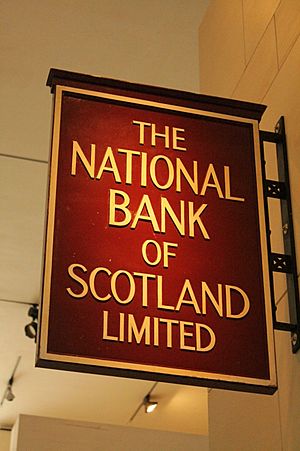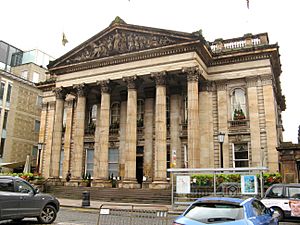National Bank of Scotland facts for kids
The National Bank of Scotland was a bank started in 1825. It was based in Edinburgh, Scotland. Over its first 100 years, it grew to have 137 branches. In 1918, a bigger bank called Lloyds Bank bought it. However, the National Bank of Scotland kept running on its own until 1959. Then, it joined with the Commercial Bank of Scotland to form a new bank called the National Commercial Bank of Scotland. Ten years later, this new bank merged with the Royal Bank of Scotland.
Contents
A Bank for Scotland
In December 1824, people in Edinburgh announced plans for a new bank. This bank would be called the National Bank of Scotland. Other groups also wanted to start banks. But they decided to join forces with the National Bank's founders.
Starting Big
In March 1825, the National Bank was officially created. It had a lot of starting money, called "nominal capital," which was £5 million. The leader of Edinburgh, the Lord Provost Alexander Henderson of Press, was its first chairman. The bank opened for business in October 1825. It immediately started printing and giving out its own bank notes. In 1831, it received a royal charter. This was a special document from the King that gave it official permission to operate.
Growing Across Scotland
The word "National" in the bank's name was important. The bank wanted to open branches all over Scotland from the very beginning. By the end of its first year, it had 13 branches. By 1850, it had 40 branches. By the year 1900, it had 112 branches across the country.
The National Bank of Scotland was also the first Scottish bank to open an office in London in 1864. From 1885 to 1914, it was the second largest bank in Scotland. Only the Bank of Scotland was bigger. Most of its growth came from opening new branches. But it also bought some smaller banks. These included the Commercial Banking Company of Aberdeen in 1833. It also bought the Perth Union Bank in 1836.
Joining Larger Banks
In the early 1900s, big English banks started looking to buy Scottish banks. In 1918, Lloyds Bank bought the National Bank of Scotland. Lloyds Bank let the National Bank keep running independently for many years.
This changed in 1959. The Commercial Bank of Scotland wanted to merge with the National Bank. Lloyds Bank agreed to sell its share of the National Bank. The two Scottish banks then merged. They became the National Commercial Bank of Scotland. Lloyds Bank still owned a part of this new, bigger bank.
Mobile Banking Pioneer
The National Bank of Scotland was very innovative. In 1946, it became the first commercial bank in the world to offer a mobile banking service. This service started on the Isle of Lewis. It allowed people in remote areas to access banking services from a special vehicle. In 1947, the bank opened a new main office in St. Andrew Square.



